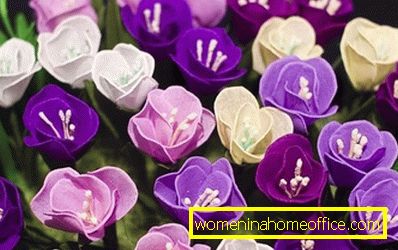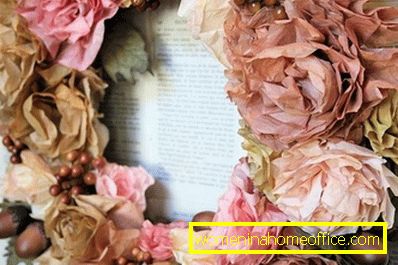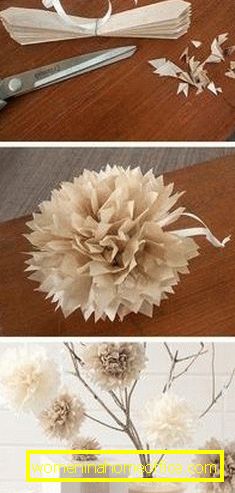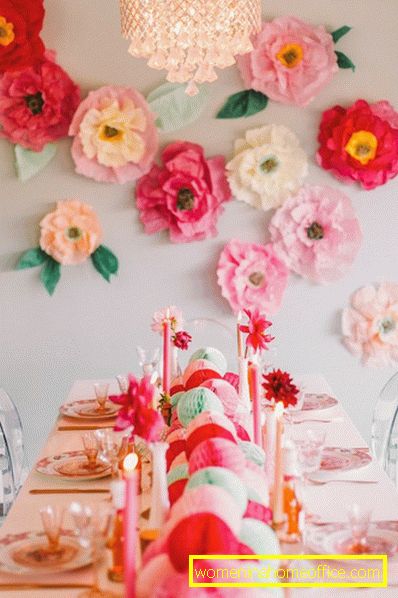Corrugated paper flowers
Corrugated paper is a very malleable, bright and inexpensive material. It seems her possibilities are endless. From this material beautiful flowers turn out, which sometimes have almost indistinguishable similarity with their living analogues. To make them very easy and pleasant.
Corrugated Tulip
In ancient times, many legends and stories were associated with this flower. For example, in England it was believed that the bowls of tulips served as cradles for elves. And the ancient legend says that real happiness was kept in the bud of a yellow tulip, and no one could get it out until one day the son of a poor woman broke out of her mother’s hands and ran to this flower with a smile and a cheerful laugh. In this very moment, the bud opened.

However, to build the cradle of elves or symbolic "flowers of happiness" is a snap. For this you need corrugated paper and wire.
First, along the corrugation line, cut six strips measuring three to eighteen centimeters. Then, you need to twist each of the strips twice in a bow and fold in half. Next, make a convex petal by stretching two layers of paper. Now you need to squeeze the base and tighten.
-
 Handmade bride bouquets
Handmade bride bouquets -
 How to pack a bouquet?
How to pack a bouquet? -
 Florists for beginners
Florists for beginners
Then we make the stem. Take a strip of green paper two centimeters wide. It should be cut across the corrugation line. Then, folding the strip in half, wind the wire with it and glue it. Then, tie up three inner lobes to the wire, then three outer ones. Tie it all up with a strip of green paper with glue. The leaves should be cut out of thick two-sided paper and twisted. Corrugated paper tulip ready!

Corrugated paper crocuses
With the arrival of spring, these flowers are among the first to appear from under the snow. The well-known seasoning saffron is nothing more than dried crocus pollen. These beautiful plants were known before our era. To make paper crocuses, you actually need paper and wire.
In general, the implementation mechanism is the same as that of tulips. Only the size of the strips for the petals should be two and a half by thirteen centimeters. The wire for the stem should be about seven to nine centimeters. It is necessary to put a yellow or orange heart inside the flower.

It is a cylinder with a fringe at the tips. Then, we wind the petals to the stalk in the same way as in the manufacture of a tulip. Only from above we fix them not with green paper, but with paper of the same color as the petals themselves. Then you need to glue the sepals of white paper and leaves. A few crocuses stick in a pot filled with clay.
-
 How to change the color of flowers?
How to change the color of flowers? -
 A ball of flowers with their own hands
A ball of flowers with their own hands -
 What does the color of flowers mean?
What does the color of flowers mean?
Corrugated paper roses
For making roses, you will need twelve pieces of corrugated paper (for petals), green corrugated paper for the stem and leaves, a wire consisting of several wires connected together, white and yellow stamen paper, a small ball and glue.

Divide the wire into twigs, each of which is wrapped in white corrugated paper, and pasted a little yellow on top. Secure the paper with glue.
Now we make petals. For this we need a small ball. It is better to make flowers in which the petals will be arranged in two rows, and the inner row will consist of smaller petals. To make the petals, just take a ball and a rectangle of paper. Wrap the ball of paper and twist on both sides. Then, attach each of the petals to the rose and flatten the edges. From above fix a strip of green paper, as a tulip.
Corrugated paper flowers: photo












The resulting flowers can be used for decorating the premises, as an accessory for clothes or even in wedding bouquets. It all depends on your imagination.